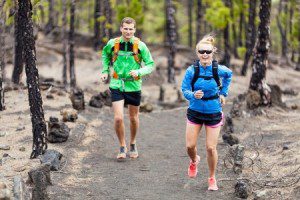
If you love to run, then there might be no better time to switch up your pavement pounding ways than the fall season. While roads, paved paths, and possibly even beaches were great for spring and summer months, trail running was almost made for autumn. Surrounded by natural beauty with the awe-inspiring color changes of canopies overhead, you couldn’t ask for a more scenic form of fitness. Plus, the air is likely cooler and the leaf-covered ground is likely softer, giving your body a bit of break from the heat and joint-jarring ways of the streets.
Even though you’re still doing the physical act of running, adding mud, rocks, and all things wilderness is a complete game changer for your body and your mind, offering lots of benefits. You’ll work your muscles in new ways, adding strength and stabilization that you wouldn’t necessarily obtain from smoother surfaces. Up and down terrain will boost your stamina and endurance, not to mention burn fat in ways different from a road-style run. And since you need to be hyper aware of where you step, you’ll gain an almost yoga-like focus keeping you present and in the moment, whereas your flatland running allows you to zone out more.
Ready to change the pace of your everyday foot race? Use our helpful tips and tricks to help you hit the trails.
Rookie Trail Running
If you’re a complete newbie to trail running, congrats! You’re about to embark on an adventure that will better your body, mind, and running style. It can be a little scary to try something new, but the good news is the learning curve is small. After all, trail running is simply running (or jogging) on a non-paved surface.
The biggest difference between the two might be the gear you need. Roots, rocks, and soggy soil are no match for street running shoes, which often have slicker soles that could cause you to trip and slip. The goal of trail running is to improve your fitness, not cause an injury. Look for a shoe that is lightweight, water-resistant, and has a grippy sole that expels mud and debris easily–otherwise your shoes will start to feel heavy as more buildup occurs. Traction is key when running trails, so work with a professional in trail running shoes to find a pair perfect for you.
Depending on how far you plan to go and how isolated you might be, other gear you might need includes:
- Layers: Even on warmer days, it can get chilly when overhead trees block out the sun.
- Sunscreen: If you’re running in higher altitudes and are exposed to the sun, be sure to wear sunscreen. Your skin can get burned even in the winter.
- Insect repellent: Bugs love to hang out in the woods, so avoid letting them bug you.
- Water: Hydration is key. While water fountains may have been more accessible on park paths, it might be miles before you find access to something drinkable. Stay prepared by carrying bottles or a hydration backpack.
Safety Matters
Knowing where you’re going, how long you’ll be gone for, the predicted weather forecast, and what you’ll need is crucial information when trail running. When possible, run with a friend so that in case you twist an ankle, you’ll have someone to assist you off the trail. If solo is your style, at least let a friend or relative know where you’re headed before your run.

Be sure to run with a cell phone, but remember that tree coverage or remote areas can sometimes make service spotty at best. Be sure to have backup plans in the way of food and water reserves, additional clothing, and trail maps. The more prepared you are, the safer you’ll stay.
Switching Styles
You’ll feel your muscles working in new ways when you switch from pavement to trails. Remember that your body may fatigue faster, so be sure to start slowly with shorter distances to begin. Also, be sure to adapt to your foot strike to the new terrain. A mid-to-forefoot strike may be similar to what you used on pavement, but ground variance and obstacles may mean changing on the fly. Be light on your feet so that you can more easily maneuver around rocks, roots, and fallen branches.
Not great at running on paved surfaces? That’s no reason to avoid trails. You can still build up your running strength and stamina by taking a similar approach on trails that you would’ve on roads. Do so by using intervals of walking and running. When first starting, your walking periods will be longer than your running periods. However, over time, this will start to change. The more increased running sessions you add, the less walking you’ll need to do. Before long, you’ll be jogging the entire distance, and with more training, running at faster speeds.
Love to run? Share with others in the comments your favorite places to lace up and sweat it out.

Leave a Reply